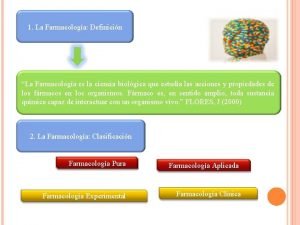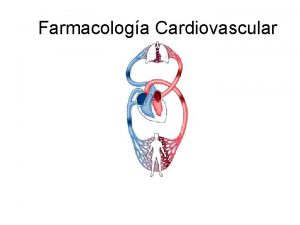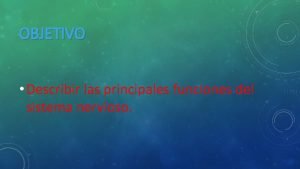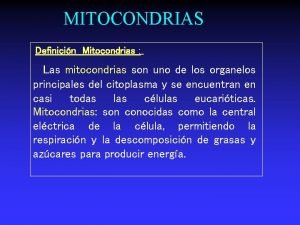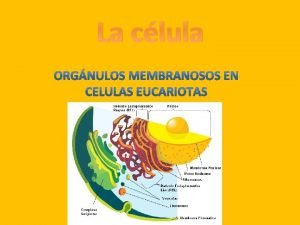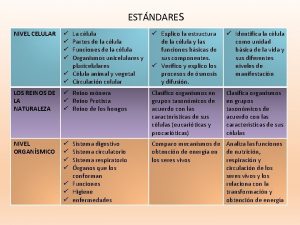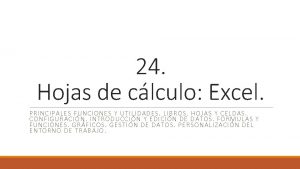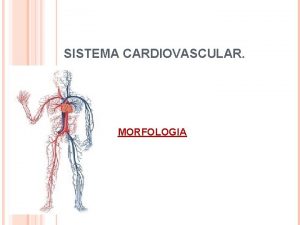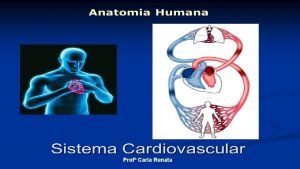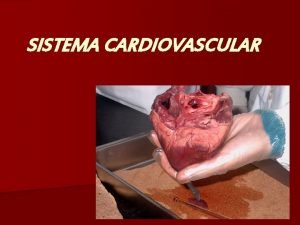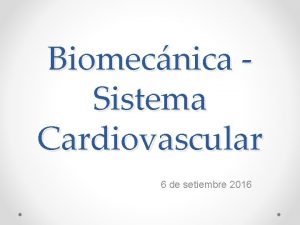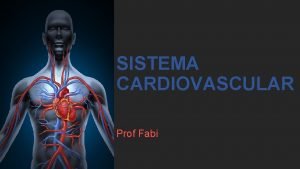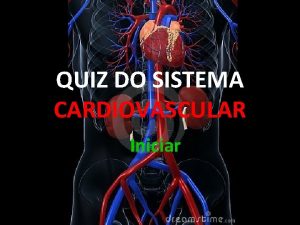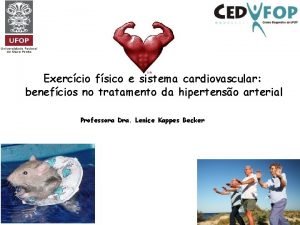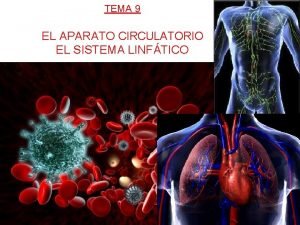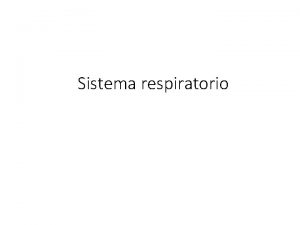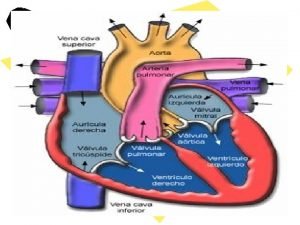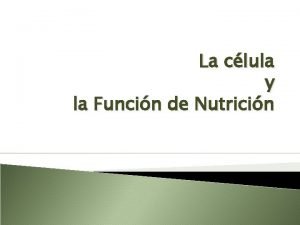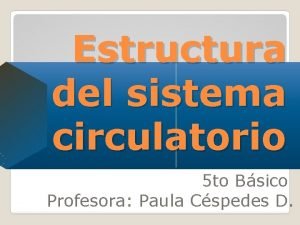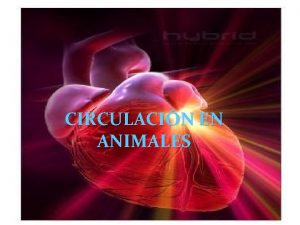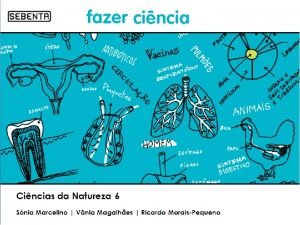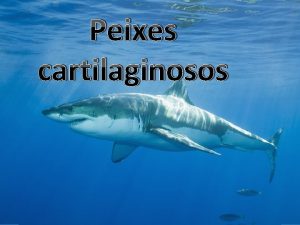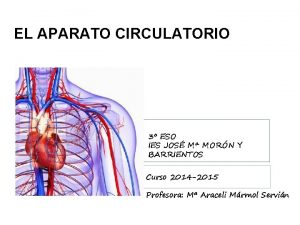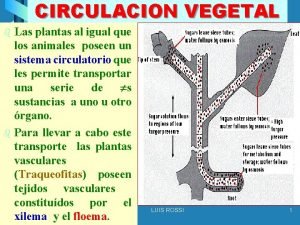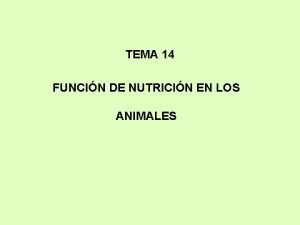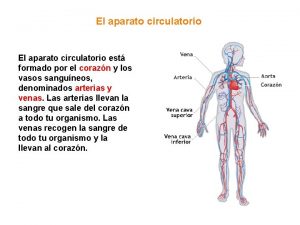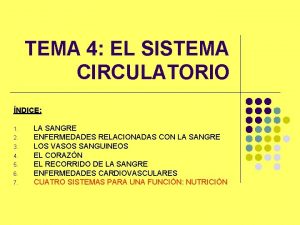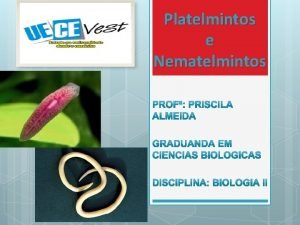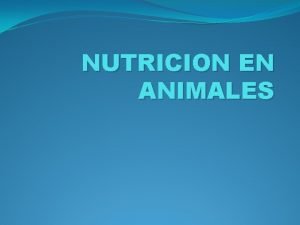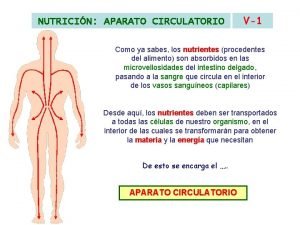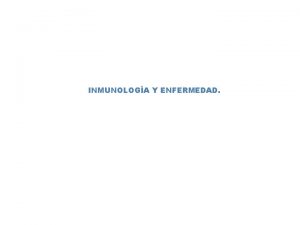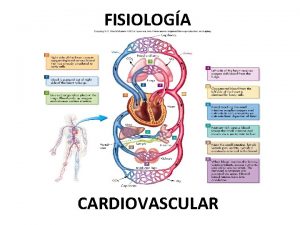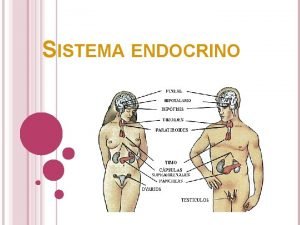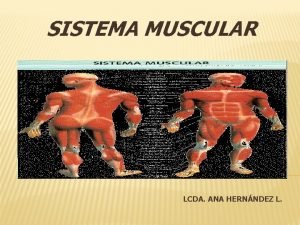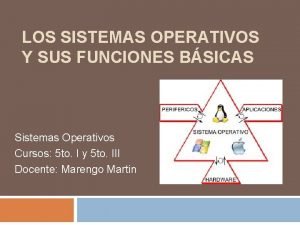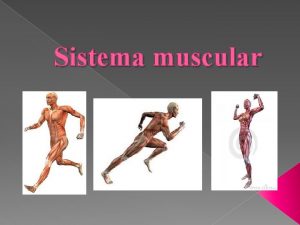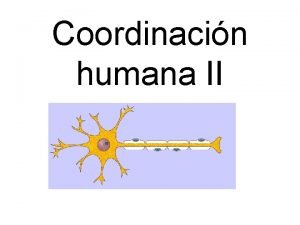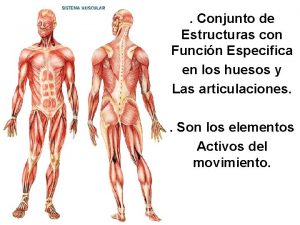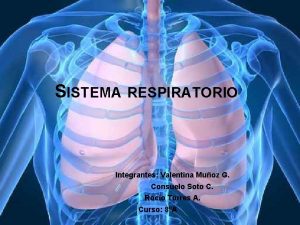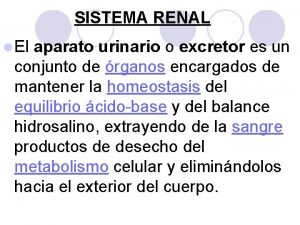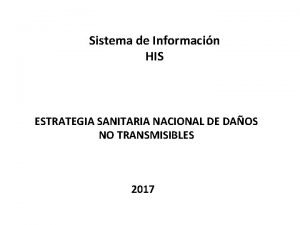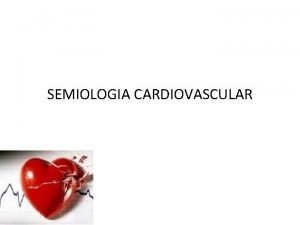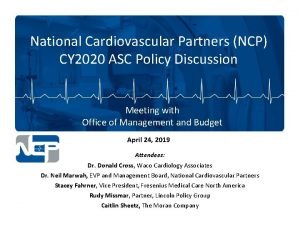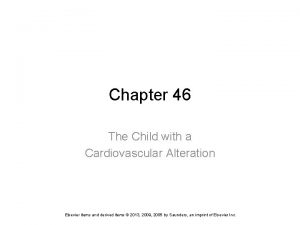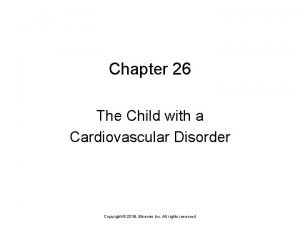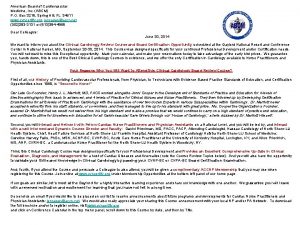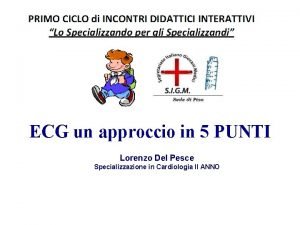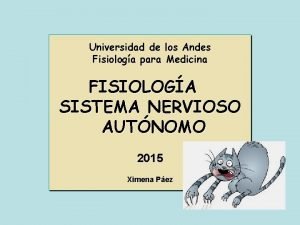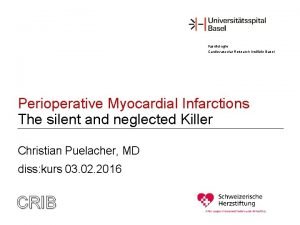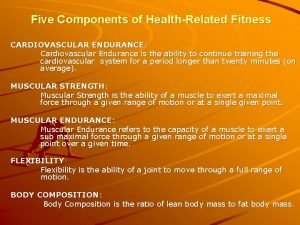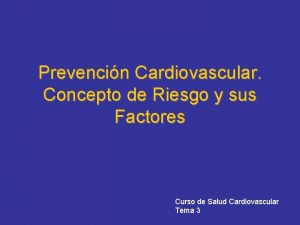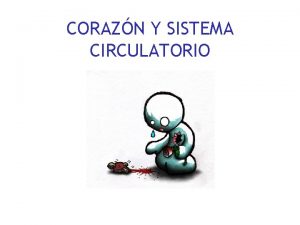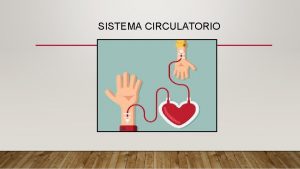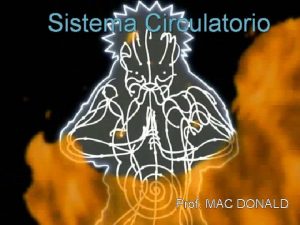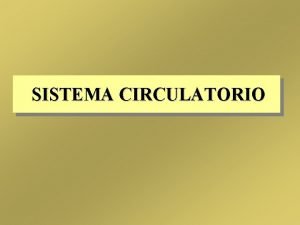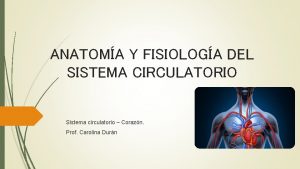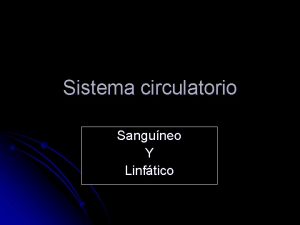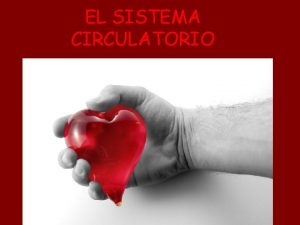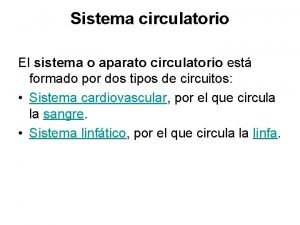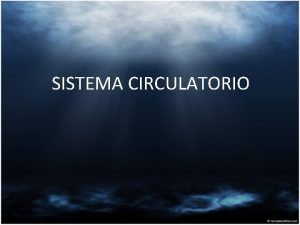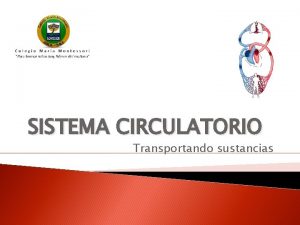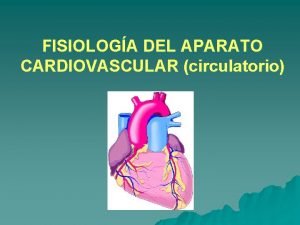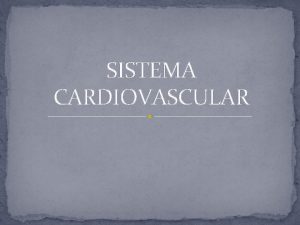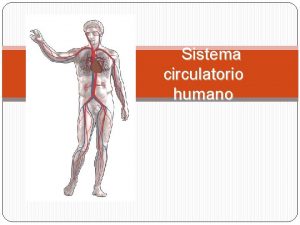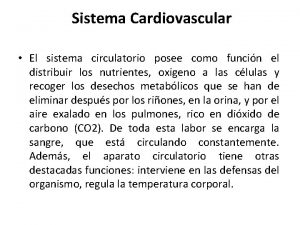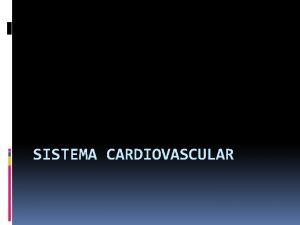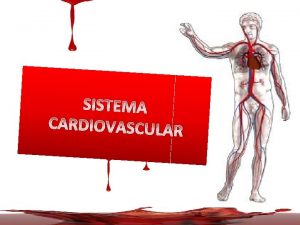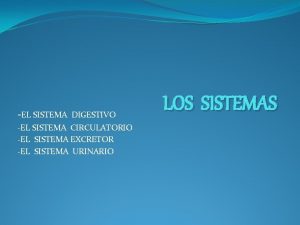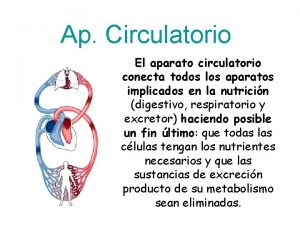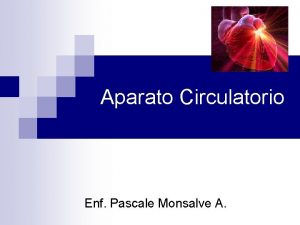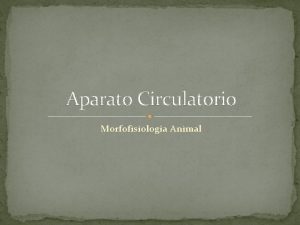Farmacologa Cardiovascular SISTEMA CIRCULATORIO FUNCIONES PRINCIPALES Transportar y











































![Side Effects of Diuretics • • • electrolyte losses [Na+ & K+ ] fluid Side Effects of Diuretics • • • electrolyte losses [Na+ & K+ ] fluid](https://slidetodoc.com/presentation_image/43caf3f97f29463cd64ecaae61cbfd00/image-44.jpg)
![Vasodilators • • diazoxide [Hyperstat®] hydralazine [Apresoline®] minoxidil [Loniten®] sodium Nitroprusside [Nipride®] Vasodilators • • diazoxide [Hyperstat®] hydralazine [Apresoline®] minoxidil [Loniten®] sodium Nitroprusside [Nipride®]](https://slidetodoc.com/presentation_image/43caf3f97f29463cd64ecaae61cbfd00/image-45.jpg)





























- Slides: 74

Farmacología Cardiovascular

SISTEMA CIRCULATORIO: FUNCIONES PRINCIPALES • Transportar y distribuir sustancias esenciales a los tejidos • Remover desechos metabólicos • Ajustar la provisión de oxígeno y nutrientes en diferentes estados metabólicos • Regulación de la temperatura corporal • Comunicación humoral

Un sistema complicado

Que se puede simplificar SERIES AND PARALLEL CIRCUITS



CICLO CARDIACO

Potencial de acción cardíaco ATRIUM VENTRICLE 0 mv mv 0 -80 mv SA NODE mv 0 -80 mv time

Conductacias del PA cardíaco

Corrientes y PA cardíaco Fast K closes Fast K reopens Slow K opens ("Delayed rectifier")

Del PA al ECG




AV NODE AND AV BLOCKS FOCUS ON N REGION NORMAL 1 ST DEGREE PROLONGUED AV CONDUCTION TIME 2 ND DEGREE 1/2 ATRIAL IMPULSES CONDUCTED TO VENTRICLES 3 RD DEGREE VAGAL MEDIATION IN N REGION/COMPLETE BLOCK ECG



ENFERMEDAD CARDÍACA • Cardiovascular disease is the major cause of death • Cardiovascular function based on – Cardiac pumping ability • Pace-making electrical signals • Force of contraction • Height of ventricle discharge pressure – Integrity of vasculature • Presence of blockage • Muscular tone/structural integrity • Pressure drop needed to move blood to and through capillary beds – Blood volume/composition • Water, electrolyte, iron balances • Lipid and protein composition

Patologías cardiovasculares que requieren farmacoterapia • • Hipertensión Arritmia Falla cardíaca Trastornos de flujo vascular

I. Background to Hypertension Regulation of Blood Pressure • Arterial blood pressure due to combination of cardiac output (CO) and total peripheral resistance (TPR) • CO – regulated by heart rate and stroke volume (CO = HR x SV) • TPR function of – Viscosity of blood (hematocrit) – Length of blood vessels – Blood vessel luminal diameter (especially precapillary arterioles)

Cardiac Output • Heart rate – Function of • sympathetic, vagal nervous activity • Neuro-hormonal substances – 1° angiotensin II – 2º vasopression (anti-diuretic hormone = ADH) • Stroke volume – Function of • Venous return (function of venous tone [contractile state] and circulating blood (vascular) volume) – Venous tone function of sympathetic activity (α 1, α 2 receptors) – Vascular volume depends on » Intake of fluids (thirst) » Output of fluids (urine, sweat, etc) » Distribution of fluids (Starling’s law) • Myocardial contractility (MC proportional to sympathetic tone [β 1 receptors])

Characteristics of some adrenoceptors Tissues (sympatheticreceptors nerves) and effects α 1 α 2 constrict/ dilate β 1 β 2 Smooth muscle Arteries/ veins dilate Skeletal muscle dilate Heart Rate (increase) Force of contraction increase

Autonomic Regulation of the Heart • Heart Rate – Parasympathetic input via vagus nerve causes decrease in HR (dominates) – Sympathetic input to sino-atrial node causes increase in HR (usually minor) • Heart contractility – Increased by sympathetic activity causing release of epinephrine, norepinephrine from adrenal gland

Hipertensión

Antihypertensive Classes • diuretics • beta blockers • angiotensin-converting enzyme (ACE) inhibitors • calcium channel blockers • vasodilators

Alpha 1 Blockers Stimulate alpha 1 receptors -> hypertension Block alpha 1 receptors -> hypotension • doxazosin (Cardura®) • prazosin (Minipress®) • terazosin (Hytrin®)

Central Acting Adrenergics • Stimulate alpha 2 receptors – inhibit alpha 1 stimulation • hypotension • clonidine (Catapress®) • methyldopa (Aldomet®)

Peripheral Acting Adrenergics • • • reserpine (Serpalan®) inhibits the release of NE diminishes NE stores leads to hypotension Prominent side effect of depression – also diminishes seratonin

Adrenergic Side Effects • Common – dry mouth, drowsiness, sedation & constipation – orthostatic hypotension • Less common – headache, sleep disturbances, nausea, rash & palpitations

Sistema renina-angiotensina

ACE Inhibitors RAAS Angiotensin I . ACE Angiotensin II 1. potent vasoconstrictor - increases BP 2. stimulates Aldosterone - Na+ & H 2 O reabsorbtion

Renin-Angiotensin Aldosterone System • • Angiotensin II = vasoconstrictor Constricts blood vessels & increases BP Increases SVR or afterload ACE-I blocks these effects decreasing SVR & afterload

ACE Inhibitors • Aldosterone secreted from adrenal glands cause sodium & water reabsorption • Increase blood volume • Increase preload • ACE-I blocks this and decreases preload

Angiotensin Converting Enzyme Inhibitors • • captopril (Capoten®) enalapril (Vasotec®) lisinopril (Prinivil® & Zestril®) quinapril (Accupril®) ramipril (Altace®) benazepril (Lotensin®) fosinopril (Monopril®)

Calcium Channel Blockers • Used for: • Angina • Tachycardias • Hypertension

Antagonistas de calcio como vasodilatadores

Calcium Channel Blockers • diltiazem (Cardizem®) • verapamil (Calan®, Isoptin®) • nifedipine (Procardia®, Adalat®)

CCB Site of Action diltiazem & verapamil nifedipine (and other dihydropyridines)

CCB Action • diltiazem & verapamil • decrease automaticity & conduction in SA & AV nodes • decrease myocardial contractility • decreased smooth muscle tone • decreased PVR • nifedipine • decreased smooth muscle tone • decreased PVR

Side Effects of CCBs • Cardiovascular • hypotension, palpitations & tachycardia • Gastrointestinal • constipation & nausea • Other • rash, flushing & peripheral edema

Diuretics • Thiazides: • chlorothiazide (Diuril®) & hydrochlorothiazide (HCTZ®, Hydro. DIURIL®) • Loop Diuretics • furosemide (Lasix®), bumetanide (Bumex®) • Potassium Sparing Diuretics • spironolactone (Aldactone®)

Diuretic Site of Action. Distal tubule proximal tubule Collecting duct loop of Henle

Mechanism • Water follows Na+ • 20 -25% of all Na+ is reabsorbed into the blood stream in the loop of Henle • 5 -10% in distal tubule & 3% in collecting ducts • If it can not be absorbed it is excreted with the urine • Blood volume = preload !
![Side Effects of Diuretics electrolyte losses Na K fluid Side Effects of Diuretics • • • electrolyte losses [Na+ & K+ ] fluid](https://slidetodoc.com/presentation_image/43caf3f97f29463cd64ecaae61cbfd00/image-44.jpg)
Side Effects of Diuretics • • • electrolyte losses [Na+ & K+ ] fluid losses [dehydration] myalgia N/V/D dizziness hyperglycemia
![Vasodilators diazoxide Hyperstat hydralazine Apresoline minoxidil Loniten sodium Nitroprusside Nipride Vasodilators • • diazoxide [Hyperstat®] hydralazine [Apresoline®] minoxidil [Loniten®] sodium Nitroprusside [Nipride®]](https://slidetodoc.com/presentation_image/43caf3f97f29463cd64ecaae61cbfd00/image-45.jpg)
Vasodilators • • diazoxide [Hyperstat®] hydralazine [Apresoline®] minoxidil [Loniten®] sodium Nitroprusside [Nipride®]


Mechanism of Vasodilators • Directly relaxes arteriole smooth muscle • Decrease SVR = decrease afterload

Nitratos como vasodilatadores

Side Effects of Vasodilators • hydralazine (Apresoline®) – Reflex tachycardia • sodium nitroprusside (Nipride®) – Cyanide toxicity in renal failure – CNS toxicity = agitation, hallucinations, etc.

II. Background to Arrhythmia Rhythm of the Heart • Human heart is fourchambered • Chambers need to contract sequentially (atria, then ventricles) and in synchronicity • Also need relaxation between contractions to allow refilling of chambers • Above controlled electrically (Purkinje fibers allow rapid, organized spread of activation)

Regulation of Heart Rate – Primarily accomplished by sinoatrial node (SA) • Located on right atrium • Receives autonomic input • When stimulated, SA signals atrial contractile fibers atria depolarization and contraction (primes ventricles with blood) – Depolarization picked up by atrioventricular node (AV node) depolarizes ventricles blood discharged to pulmonary artery and dorsal aorta eventually rest of body

Sequential Discharge of SA and AV nodes

Dysrhythmia Generation • Abnormal conduction • Analogies: – One way valve – Buggies stuck in muddy roads

Antiarrítmicos: conducción cardíaca

Antiarrítmicos: bloqueo de canales de sodio

Warning! • All antidysrhythmics have arrythmogenic properties • In other words, they all can CAUSE dysrhythmias too!

Class I: Sodium Channel Blockers • Decrease Na+ movement in phases 0 and 4 • Decreases rate of propagation (conduction) via tissue with fast potential (Purkinje) – Ignores those with slow potential (SA/AV) • Indications: ventricular dysrhythmias

Class Ia Agents • Slow conduction through ventricles • Decrease repolarization rate – Widen QRS and QT intervals • May promote Torsades Pointes! • PDQ: – procainamide (Pronestyl®) – disopyramide (Norpace®) – qunidine – (Quinidex®)

Class Ib Agents • Slow conduction through ventricles • Increase rate of repolarization • Reduce automaticity – Effective for ectopic foci • May have other uses • LTMD: – – lidocaine (Xylocaine®) tocainide (Tonocard®) mexiletine (Mexitil®) phenytoin (Dilantin®)

Class Ic Agents • Slow conduction through ventricles, atria & conduction system • Decrease repolarization rate • Decrease contractility • Rare last chance drug • flecainide (Tambocor®) • propafenone (Rythmol®)

Class II: Beta Blockers • Beta 1 receptors in heart attached to Ca++ channels – Gradual Ca++ influx responsible for automaticity • Beta 1 blockade decreases Ca++ influx – Effects similar to Class IV (Ca++ channel blockers) • Limited # approved for tachycardias

Class II: Beta Blockers • propranolol (Inderal®) • acebutolol (Sectral®) • esmolol (Brevibloc®)

Class III: Potassium Channel Blockers • • Decreases K+ efflux during repolarization Prolongs repolarization Extends effective refractory period Prototype: bretyllium tosylate (Bretylol®) – Initial norepi discharge may cause temporary hypertension/tachycardia – Subsequent norepi depletion may cause hypotension

Class IV: Calcium Channel Blockers • Similar effect as ß blockers • Decrease SA/AV automaticity • Decrease AV conductivity • Useful in breaking reentrant circuit • Prime side effect: hypotension & bradycardia • verapamil (Calan®) • diltiazem (Cardizem®) • Note: nifedipine doesn’t work on heart

III. Background to Congestive Heart Failure Maintenance of Normal Heart Function • Normal cardiac output needed to adequately perfuse peripheral organs – Provide O 2, nutrients, etc – Remove CO 2, metabolic wastes, etc – Maintain fluid flow from capillaries into interstitium and back into venous system if flow reduced or pressure increased in venous system build up of interstitial fluid = edema • Because CO is a function of – Heart Rate – determined by pacemaker cells in the sinoatrial node – Stroke volume – determined by fill rate and contractile force – Atrial/ventricular/valvular coordination Any negative change on above can lead to inadequate perfusion and development of the syndrome of heart failure

FALLA CARDÍACA CAUSES: Impairment of electrical activity Muscle damage Valvular defects Cardiomyopathies Result of drugs or toxins PROBLEM: Maintaining circulation with a weak pump ( Cardiac output & cardiac reserve; RAP) SOLUTIONS: Sympathetic tone via baroreceptor reflex - Heart rate and contractility -Venoconstriction ( MCP) -Vasoconstriction ( Arterial BP) Fluid retention ( MCP) -Capillary fluid shift -ADH -Renin-angiotensin-aldosterone

Glicósidos: Efectos cardíacos

IV. Background to Reduced Vascular Blood Flow: Blood Vessel Anatomy and Function • Arterial blood vessels – Smooth muscle (slow, steady contraction) – elastic tissue (stretch on systole, recoil on diastole) – Contain about 10% of blood volume – Arterioles have sphincters which regulate 70% of blood pressure • Venous blood vessels – Highly distensible, some contractility – Contain over 50% of blood volume • Capillaries – Tiny but contain greatest cross-sectional area to allow high exchange rate – Contain precapillary sphincters to regulate blood flow – 5% of blood volume All vasculature under ANS and humeral control

Misc. Agents • adenosine (Adenocard®) – Decreases Ca++ influx & increases K+ efflux via 2 nd messenger pathway • Hyperpolarization of membrane • Decreased conduction velocity via slow potentials • No effect on fast potentials • Profound side effects possible (but shortlived)

Misc. Agents • Cardiac Glycocides • digoxin (Lanoxin®) – Inhibits Na. KATP pump – Increases intracellular Ca++ • via Na+-Ca++ exchange pump – Increases contractility – Decreases AV conduction velocity

Fármacos con acción cardíaca

Tratamiento de la angina de pecho (angor)

Tratamiento del infarto agudo de miocardio

Tratamiento del infarto agudo de miocardio
 Nomenclatura de los fármacos
Nomenclatura de los fármacos Funciones del sistema circulatorio
Funciones del sistema circulatorio Tres funciones del sistema nervioso
Tres funciones del sistema nervioso Qual é a única coisa que uma onda pode transportar
Qual é a única coisa que uma onda pode transportar Definicion de mitocondrias
Definicion de mitocondrias Funcion de reticulo endoplasmatico liso
Funcion de reticulo endoplasmatico liso Principales funciones de la celula
Principales funciones de la celula Excel principales funciones y utilidades
Excel principales funciones y utilidades Sistema digestivo
Sistema digestivo Pequena circulacao
Pequena circulacao Pequena circulação e grande circulação
Pequena circulação e grande circulação Sistema cardiovascular sus partes
Sistema cardiovascular sus partes Nó sinoatrial
Nó sinoatrial Sistema cardiovascular quiz
Sistema cardiovascular quiz Sistema cardiovascular
Sistema cardiovascular Ventriculos
Ventriculos Sistema circulatorio doble incompleto
Sistema circulatorio doble incompleto Qué es el aparato respiratorio
Qué es el aparato respiratorio Aparato circulatorio
Aparato circulatorio Estrutura corporal moluscos
Estrutura corporal moluscos En qué consiste el sistema circulatorio cerrado
En qué consiste el sistema circulatorio cerrado Ametaméricos
Ametaméricos Estructura de sistema circulatorio
Estructura de sistema circulatorio Aparato circulatorio caracol
Aparato circulatorio caracol Sistema circulatório
Sistema circulatório Sistema circulatorio condrictes
Sistema circulatorio condrictes Enfermedades aparato circulatorio 3 eso
Enfermedades aparato circulatorio 3 eso Circulacion del reino vegetal
Circulacion del reino vegetal Sistema circulatorio cerrado
Sistema circulatorio cerrado Cual es el radio en el cuerpo humano
Cual es el radio en el cuerpo humano Atividades sistema circulatorio 5 ano
Atividades sistema circulatorio 5 ano Cuadro de sistema circulatorio
Cuadro de sistema circulatorio Sistema digestivo nematoides
Sistema digestivo nematoides Animales con aparato digestivo incompleto.
Animales con aparato digestivo incompleto. El aparato circulatorio
El aparato circulatorio Porque es importante el sistema circulatorio
Porque es importante el sistema circulatorio Ley de poiseuille formula
Ley de poiseuille formula Sistema endocrino hombre
Sistema endocrino hombre Musculos esfinterianos
Musculos esfinterianos Funcion de los sistemas operativos
Funcion de los sistemas operativos Musculos fusiformes
Musculos fusiformes Sistema nervioso periférico y central
Sistema nervioso periférico y central Funciones del sistema muscular
Funciones del sistema muscular Función del sistema nervioso
Función del sistema nervioso Partes del aparato respiratorio
Partes del aparato respiratorio Funciones del sistema urinario
Funciones del sistema urinario Arterial blood vs venous blood
Arterial blood vs venous blood Riesgo cardiovascular por perimetro abdominal
Riesgo cardiovascular por perimetro abdominal Maniobra de azoulay
Maniobra de azoulay What makes up the circulatory system
What makes up the circulatory system Rias cardiovascular
Rias cardiovascular Pithed rat model
Pithed rat model National cardiovascular partners
National cardiovascular partners Totally tubular dude
Totally tubular dude Heart rate during exercise
Heart rate during exercise Crash course cardiovascular system
Crash course cardiovascular system Cengage learning heart diagram
Cengage learning heart diagram Chapter 46 the child with a cardiovascular alteration
Chapter 46 the child with a cardiovascular alteration Chapter 26 the child with a cardiovascular disorder
Chapter 26 the child with a cardiovascular disorder Chapter 25 assessment of cardiovascular function
Chapter 25 assessment of cardiovascular function Figure 11-7 veins labeled
Figure 11-7 veins labeled Figure 11-14 is a diagram of a capillary bed
Figure 11-14 is a diagram of a capillary bed Chapter 11 the cardiovascular system
Chapter 11 the cardiovascular system Lesson 11 cardiovascular system
Lesson 11 cardiovascular system American board of cardiovascular medicine
American board of cardiovascular medicine Life
Life Neuronas sensoriales
Neuronas sensoriales Agranulocytes
Agranulocytes Anatomy blood vessels
Anatomy blood vessels Isgemiese hartsiekte
Isgemiese hartsiekte Introduction of heart
Introduction of heart What is cardiovascular endurance in health related fitness
What is cardiovascular endurance in health related fitness Ptca
Ptca Salud cardiovascular
Salud cardiovascular Health related fitness grade 7
Health related fitness grade 7
